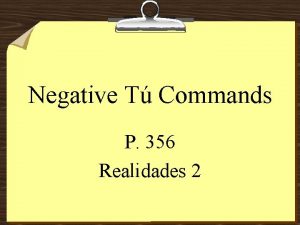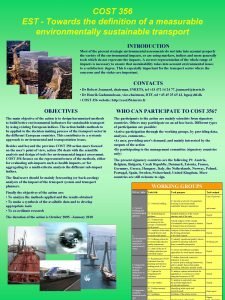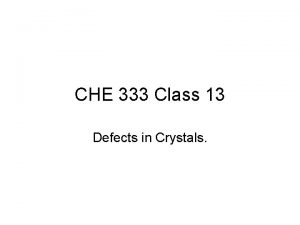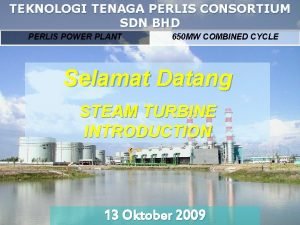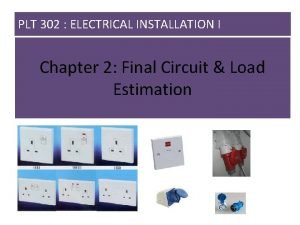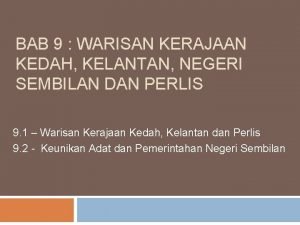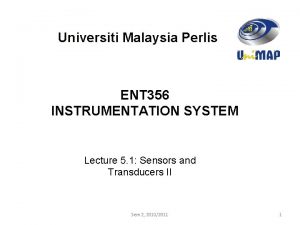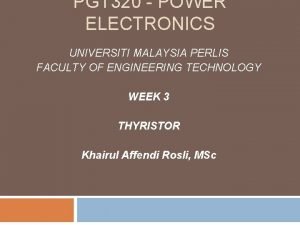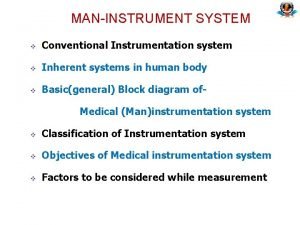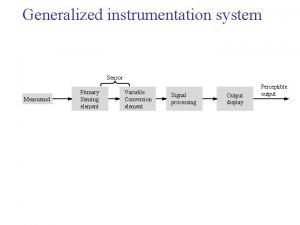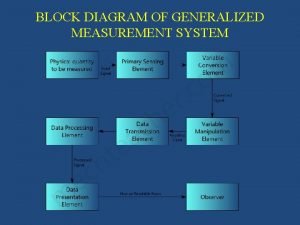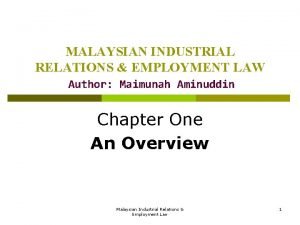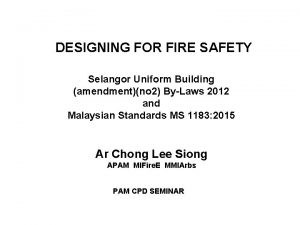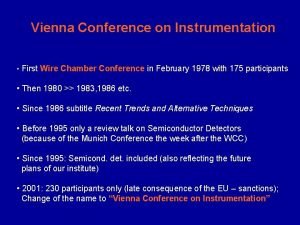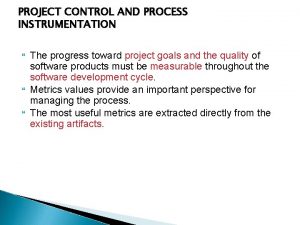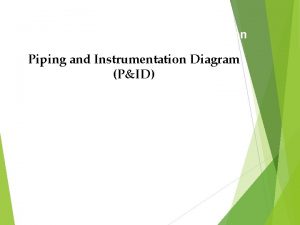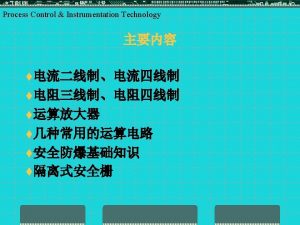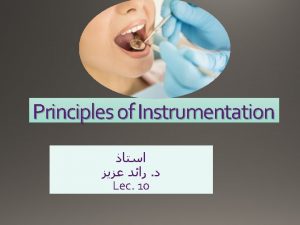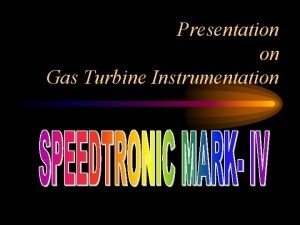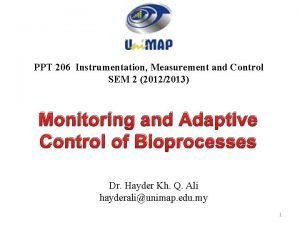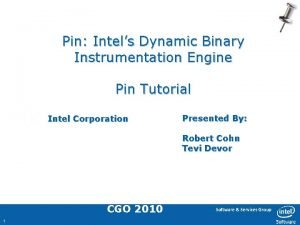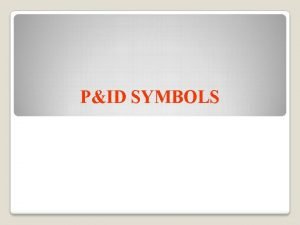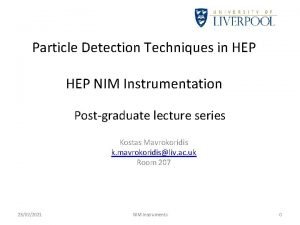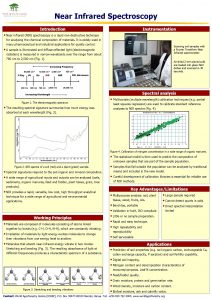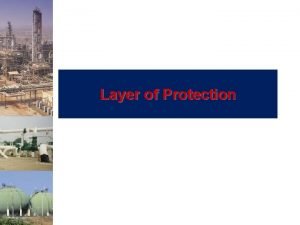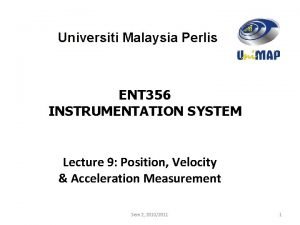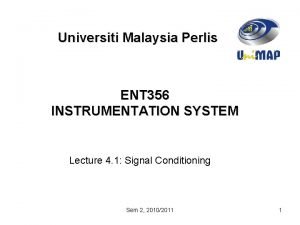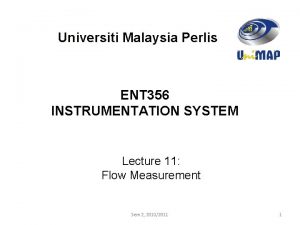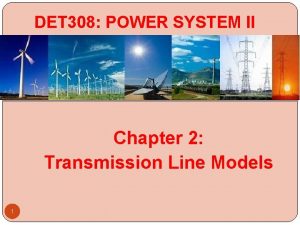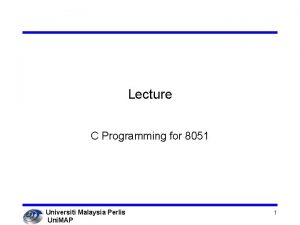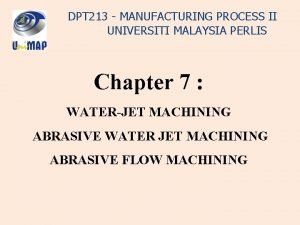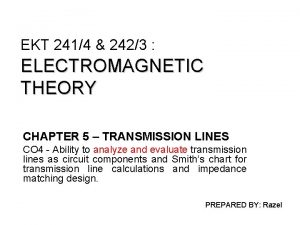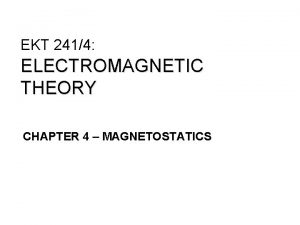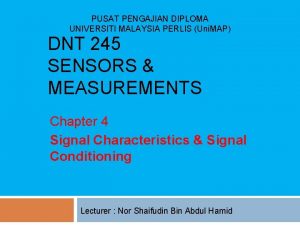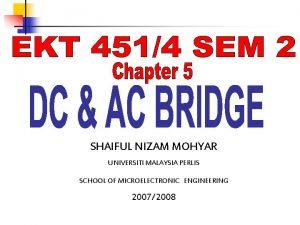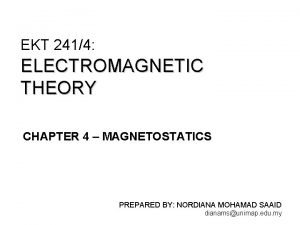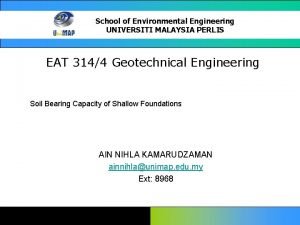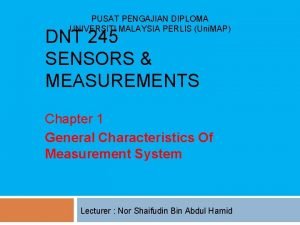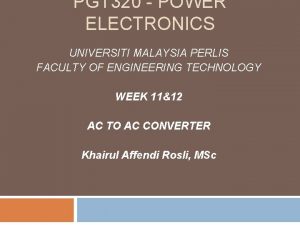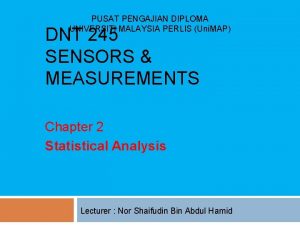Universiti Malaysia Perlis ENT 356 INSTRUMENTATION SYSTEM Lecture




















































- Slides: 52

Universiti Malaysia Perlis ENT 356 INSTRUMENTATION SYSTEM Lecture 5. 1: Sensors and Transducers II Sem 2, 2010/2011 1

1. 0 INTRODUCTION q A basic instrument system consists of three elements: § SENSOR or INPUT DEVICE § SIGNAL PROCESSOR § RECEIVER or OUTPUT DEVICE q This lecture part is devoted to input devices (sensing) but you can never separate it from the rest of the system as in many cases they are all integral (e. g. a mechanical pressure gauge incorporates all of these elements). q A block diagram of a basic system is shown but they are usually more complex.

The block diagram of a sensor is shown below. Things that are commonly measure: §Temperature §Pressure §Speed §Flow rate §Force §Movement, Velocity and Acceleration §Displacement §Stress and Strain §Level or Depth §Mass or Weight §Density §Size or Volume §Acidity/Alkalinity Sensors may operate simple on/off switches to detect the following: §Objects(Proximity switch) §Empty or full (level switch) §Hot or cold (thermostat) §Pressure high or low (pressure switch)

2. 0 TEMPERATURE TRANSDUCER q When two wires with dissimilar electrical properties are joined at both ends and one junction is made hot and the other cold, a small electric current is produced proportional to the difference in the temperature. q *Seebeck discovered this effect – the Thermoelectric effect. q It is true no matter how the ends are joined so the cold end may be joined at a sensitive millivolt meter. The hot junction forms the sensor end. *Thomas Johann Seebeck, (9/4/1770 – 10/12/1831), Estonian-German physicist.

2. 1 Thermocouples The picture shows a typical industrial probe with a flexible extension and standard plug.

q *Peltier showed that heat is absorbed at the hot end and rejected at the cold end. q *Thompson showed that part of the e. m. f. is due to the temperature gradient in the wire as well as the temperature difference between the junctions. q Most thermocouple metals produce a relationship between the two temperatures and the e. m. f as follows. where α and β are constants for the type of thermocouple. q The relationship is nearly linear over the operating range. q The actual characteristic and suitable operating temperatures depends upon the metals used in the wires. *Jean Charles Athanase Peltier (22/2/1785 – 27/10/1845, French physicist. *Thomson, 1 st Baron Kelvin (26/6/1824 – 17/12/1907), British mathematical physicist and engineer

2. 2 Resistance Type Sensors q Main principle: the electrical resistance of a conductor change with temperature. q If a constant voltage is applied to the conductor then the current flowing through it will change with temperature. q The resistivity of the conductor change with temperature. This usually means the resistance gets bigger as the conductor gets hotter. q The following law relates the resistance and temperature. where α is the temperature coefficient of resistance and Ro is the resistance at 0 o. C. q A basic temperature sensor is made by winding a thin resistance wire into a small sensor head. q The resistance of the wire then represents the temperature. This has an advantage over a thermocouple in that it is unaffected by the temperature of the gauge end. q The main type of wire used is platinum.

2. 3 Liquid Expansion and Vapor Pressure Sensors q These are thermometers filled with either a liquid such as mercury or an evaporating fluid such as used in refrigerators. q In both cases the inside of the sensor head and the connecting tube are completely full. q Any rise in temperature produces expansion or evaporation of the liquid so the sensor becomes pressurised. q The pressure is related to the temperature and it may be indicated on a simple pressure gauge. q Ways and means exist to convert the pressure into an electrical signal. The movement may also directly operate a thermostat. q These instruments are robust and used over a wide range. They can be fitted with electric switches to set off alarms.

2. 4 Bimetallic Types q It is a well-known principle that if two metals are rigidly joined together as a twolayer strip and heated, the difference in the expansion rate causes the strip to bend. q In the industrial type, the strip is twisted into a long thin coil inside a tube. One end is fixed at the bottom of the tube and the other turns and moves a pointer on a dial. q The outward appearance is very similar to the pressure type. They can be made to operate limit switches and set off alarms or act as a thermostat. (e. g. on a boiler). q If a rod with length lo at temperature To, and the temperature is raised to a new value T new length l is; where ΔT = T - To and is the linear thermal expansion coefficients.

2. 5 Glass Thermometer q The ordinary glass thermometer is also a complete system. q Again the bulb is the sensor but the column of liquid and the scale on the glass is the processor and indicator. q Mercury is used for hot temperatures and coloured alcohol for cold temperatures q The problems with glass thermometers are that they are: Brittle Mercury solidifies at -40 o. C. Alcohol boils at around 120 o. C. Accurate manufacture is needed and this makes accurate ones expensive. It is easy for people to make mistakes reading them. q Glass thermometers are not used much now in industry but if they are, they are usually protected by a shield from accidental breakage. q In order to measure the temperature of something inside a pipe they are placed in thermometer pockets

Examples: 1) A platinum resistance thermometer has a resistance of 100Ω at 0 o. C and the value of α is 0. 00385. In operation the resistance is 101Ω. Calculate the temperature. 2) A thermocouple produces an EMF in m. V according to the temperature difference between the sensor tip θ 1 and the gauge head θ 2 such that α=3. 5 x 10 -2 and β=8. 2 x 10 -6. The gauge head is at 20 o. C. The m. V output is 10 m. V. Calculate the temperature at the sensor. 3) How much will an aluminum rod of 10 m length at 20 o. C expand when the temperature is changed from 0 o. C to 100 o. C? *aluminum thermal coefficient is 25 x 10 -6/o. C.

3. 0 PRESSURE TRANSDUCERS • Pressure sensors either convert the pressure into mechanical movement or into an electrical output. • Complete gauges not only sense the pressure but indicate them on a dial or scale. • Mechanical movement is produced with the following elements. Bourdon Tube. Spring and Piston. Capsules and Bellows Diaphragm

3. 1 Bourdon Tube

• The Bourdon tube is a hollow tube with an elliptical cross section. • When a pressure difference exists between the inside and outside, the tube tends to straighten out and the end moves. • The movement is usually coupled to a needle on a dial to make a complete gauge. • It can also be connected to a secondary device such as an air nozzle to control air pressure or to a suitable transducer to convert it into an electric signal. • This type can be used for measuring pressure difference.

3. 2 Piston Type q The pressure acts directly on the piston and compresses the spring. q The position of the piston is directly related to the pressure. q A window in the outer case allows the pressure to be indicated. q This type is usually used in hydraulics where the ability to withstand shock, vibration and sudden pressure changes is needed (shock proof gauge). q The piston movement may be connected to a secondary device to convert movement into an electrical signal.

3. 3 Capsules and Bellows q A bellows is made of several capsules. q These are hollow flattened structures made from thin metal plate. q When pressurised, the bellows expand produce mechanical movement. If the bellows is encapsulated inside an outer container, then the movement is proportional to the difference between the pressure on the inside and outside. q Bellows and single capsules are used in many instruments. q They are very useful for measuring small pressures.

3. 4 Diaphragm q. These are similar in principle to the capsule but the diaphragm is usually very thin and perhaps made of rubber. q. The diaphragm expands when very small pressures are applied. q. The movement is transmitted to a pointer on a dial through a fine mechanical linkage.

Electrical Pressure Transducers • There are various ways of converting the mechanical movement of the preceding types into an electric signal. • The following are types that directly produce an electric signal. Strain Gauge types. Piezo-electric types.

STRAIN GAUGE TYPES • The principles of electric strain gauges are covered later. • Strain gauges are small elements that are fixed to a surface that is strained. The change in length of the element produces changes in the electrical resistance. • This is processed and converted into a voltage. A typical pressure transducer would contain a metal diaphragm which bends under pressure.

PIEZO-ELECTRIC TYPES • The element used here is a piece of crystalline material that produces an electric charge on its surface when it is mechanically stressed. • The electric charge may be converted into voltage. This principle is used in the pick up crystal of a record player, in microphones and even to generate a spark in a gas igniter. • When placed inside a pressure transducer, the pressure is converted into an electric signal.

4. 0 SPEED TRANSDUCERS • Speed transducers are widely used for measuring the output speed of a rotating object. • There are many types using different principles and most of them produce an electrical output.

4. 1 Optical Types q These use a light beam and a light sensitive cell. q The beam is either reflected or interrupted so that pulses are produced for each revolution. q The pulses are then counted over a fixed time and the speed obtained. q Electronic processing is required to time the pulses and turn the result into an analog or digital signal.

4. 2 Magnetic Pick-up Types q These use an inductive coil placed near to the rotating body. q A small magnet on the body generates a pulse every time it passes the coil. If the body is made of ferrous material, it will work without a magnet. q A discontinuity in the surface such as a notch will cause a change in the magnetic field and generate a pulse. q The pulses must be processed to produce an analogue or digital output.

4. 3 Tachometers • There are two types, A. C. and D. C. The A. C. type generates a sinusoidal output. • The frequency of the voltage represents the speed of rotation. The frequency must be counted and processed. • The D. C. type generates a voltage directly proportional to the speed. • Both types must be coupled to the rotating body. • Often the tachometer is built into electric motors to measure their speed.

5. 0 FLOW METERS There are hundreds of types of flow meters depending on the make and application. They may be classified roughly as follows. Ø Positive Displacement Types Ø Inferential Types Ø Variable Area Types Ø Differential Pressure Types

5. 1 Positive Displacement Types • These types have a mechanical element that makes the shaft of the meter rotate once for an exact known quantity of fluid. • The quantity of fluid hence depends on the number of revolutions of the meter shaft and the flow rate depends upon the speed of rotation. • Both the revolutions and speed may be measured with mechanical or electronic devices. • Some of the most common listed below. - Rotary piston type. - Vane type. - Lobe type or meshing rotor. - Reciprocating piston type - Fluted spiral gear.

5. 2 Inferential Types • The flow of the fluid is inferred from some effect produced by the flow. Usually this is a rotor which is made to spin and the speed of the rotor is sensed mechanically or electronically. • The main types are : - Turbine rotor types - Rotary shunt types - Rotating vane types - Helical turbine types

5. 3 Variable Area Types There are two main types of this meter § Float type (Rotameter) § Tapered plug type.

5. 3 Differential Pressure Types q These are a range of meters that convert flow rate into a differential pressure. q The important types conform to 1 BS 1042 standard are; Ø Orifice Meters. Ø Venturi Meters Ø Nozzle Meters Ø Pitot Tubes. q Following diagram shows a cross section through the four types of differential pressure meters. 1 BS 1042/ISO 5167: Fluid Flow Measurement Standards

DIFFERENTIAL PRESSURE FLOW METERS

q The working principle for all these is that something makes the velocity of the fluid change and this produces a change in the pressure so that a difference is created. q It can be shown for all these meters that the volume flow rate Q is related to Δp by the following formula: where K is the meter constant. q The picture shows an industrial d. p. meter. Extra instrumentation heads can be fitted to produce an electrical output (4 – 20 m. A) or a pneumatic output (0. 2 – 1 bar).

Examples; 1) A Venturi meter has a meter constant of 0. 008 m 4 N-0. 5 s-1. Calculate the flow rate when Δp=180 Pa. 2) An Orifice meter has a meter constant of 0. 004 m 4 N-0. 5 s-1. Calculate the flow rate when a differential pressure of 200 Pa is obtained.

6. 0 FORCE SENSORS The main types of force sensors are; Mechanical types. Hydraulic types. Electrical strain gauge types.

6. 1 Mechanical Types q Mechanical types are usually complete measuring systems involving some form of spring such as in a simple spring balance or bathroom scale. q It is a basic mechanical principle that the deflection of a spring is directly proportional to the applied force so if the movement is shown on a scale, the scale represents force.

6. 2 Hydraulic Types q Hydraulic types are often referred to as hydraulic load cells. q The cell is a capsule filled with liquid. q When the capsule is squeezed, the liquid becomes pressurised. q The pressure represents the force and may be indicated with a calibrated pressure gauge. q The capsule is often a short cylinder with a piston and the pressure produced is given by p = F/A where F is the force and A the piston area.

6. 3 Electrical strain gauge types q A typical load cell consists of a metal cylinder with strain gauges fixed to it. q When the cylinder is stretched or compressed, the strain gauges convert the force into a change in resistance and hence voltage. q Since the elements require a supply voltage, the cell usually has 4 wires, two for the supply and two for the output.

7. 0 DEPTH GAUGES • Depth gauges measure the depth of liquids and powder in tanks. • They use a variety of principles and produce outputs in electrical and pneumatic forms. • The type to use depends on the substance in the tank.

• The ultrasonic system reflects sound waves from the surface and determines the depth from the time taken to receive the reflected sound. • The electronic version uses a variety of electrical affects including conduction of the fluid and capacitance. • The pneumatic version bubbles air through the liquid and the pressure of the air is related to • the depth. A simple pressure gauge attached to a tank is also indicates the depth since depth is proportional to pressure.

8. 0 STRAIN GAUGES q Strain gauges are used in many instruments that produce mechanical strain because of the affect being measured. q In their own right, they are used to measure the strain in a structure being stretched or compressed. q The strain gauge element is a very thin wire that is formed into the shape shown. This produces a long wire all in one direction but on a small surface area. The element is often formed by etching a thin foil on a plastic backing. q The completed element is then glued to the surface of the material or component that will be strained. q The axis of the strain gauge is aligned with the direction of the strain. When the component is stretched or compressed, the length of the resistance wire is changed. This produces a corresponding change in the electrical resistance.

Visualization of the working concept behind the strain gauge on a beam under exaggerated bending.

q Let the length of the gauge be L and the change in length be ΔL. q The mechanical strain; q Let the resistance of the gauge be R (typically 120 Ω) and the change in resistance be ΔR. q The electrical strain; q The electrical and mechanical strain are directly proportional and the constant relating them is called the gauge factor (typically 2). q Gauge Factor, G = Electrical Strain/Mechanical strain

Example 1) A strain gauge is glued to a structure. It has a gauge factor of 2. 1 and a resistance of 120. 2Ω. The structure is stressed and the resistance changes to 120. 2Ω. Calculate the strain and convert this into stress. *Take E = 205 GPa

Strain Gauge Arrangements The strain gauge is of little use unless we can convert the change in resistance into a voltage. This is best done with a Wheatstone bridge. • If only one active gauge is used, this would be R 1 or R 2. R 1 and R 3 must be equal, so must R 2 and R 4. • In this case, the voltage at points 1 and 2 are equal to Vs/2 and so the output Vo is zero. • In order to ensure this, the balancing resistor RB is adjusted to make the output zero with no strain applied to the gauge. • Suppose that R 1 is the active gauge. If the bridge is balanced then the voltage at points 1 and 2 is half the supply voltage. V 1 = V 2 = Vs/2

When R 1 changes its resistance by ΔR, the voltage at point 1 become; (using ratio of resistances) The output now become; Dividing top and bottom by R we get; The gauge factor is defined as; Substituting we get;

Example 1) Four strain gauges are formed into bridge with only one active gauge. The nominal resistance of all of them is 120 ohms. The gauge factor is 2. 1 and the supply voltage is 10 V. Calculate the strain when the output from the bridge is 20 m. V.

Temperature Effects One of the problems with strain gauges is that the resistance also changes with temperature and so it is vital that each pair of resistors is maintained at the same temperature. q If one active gauge is used, say R 1, then the other resistor R 2 must be placed near to it and this is best done by using a DUMMY GAUGE fixed close to the active gauge but in a position where it is unstrained. q Better still, make R 2 another active gauge and so double the output from the bridge. q For example, if a beam is used to produce the strain, one gauge is placed on top and the other on the bottom as shown.

Let R 1 increase and R 2 decrease by ΔR. The voltage at point 1 becomes; (using ratio of resistances) The output becomes; Dividing top and bottom by R; which is almost double the output.

If the load cell only produces tension or compression, the active gauges are R 1 and R 4 with R 2 and R 3 being the dummy gauges. All 4 gauges are then at the same temperature. This is shown in the diagram below.

The voltage at point 1 becomes; And at point 2 becomes; The output become; Dividing top and bottom by R; This is double the output of a single active gauge and fully temperature stable.

If a beam is used in the load cell, all 4 gauges may be made active as shown. The output at point 1 becomes; and at point 2 becomes; The output becomes; This is 4 times the output of a single active gauge and fully temperature stable

Self Exercises 1) A strain gauge is glued to a structure. It has a gauge factor of 2. 1 and a resistance of 120. 2 Ω. The structure is stressed and the resistance changes to 120. 25 Ω. Calculate the strain and convert this into stress. Take E = 205 Gpa (answer: 40. 6 Mpa) 2) A strain gauge has a gauge factor of 2. 2. It is glued to tensile test piece and the resistance before straining is 119. 8 Ω. The test piece is stretched and the resistance goes up to 120 Ω. Calculate the following. The modulus of elasticity E for the test piece is 200 GPa. i. The strain in the test piece. (answ: 7. 588 x 10 -4) ii. The stress in the test piece. (answ: 15. 18 MPa)

 Perkhidmatan psikiatri di malaysia
Perkhidmatan psikiatri di malaysia Universiti putra malaysia
Universiti putra malaysia Cara pengiraan slt
Cara pengiraan slt Gred pensyarah universiti awam
Gred pensyarah universiti awam Akta 173
Akta 173 Contoh bina ayat menggunakan perkataan tatarias
Contoh bina ayat menggunakan perkataan tatarias 695 round off to the nearest hundreds
695 round off to the nearest hundreds Negative tú commands p 356 answer key
Negative tú commands p 356 answer key 356 dat
356 dat Item 276
Item 276 Ds jongejan
Ds jongejan 356 in scientific notation
356 in scientific notation 356 est
356 est Al 356
Al 356 I can help
I can help 356 - 323
356 - 323 Malaysia malaysia malaysiansleereuters
Malaysia malaysia malaysiansleereuters 01:640:244 lecture notes - lecture 15: plat, idah, farad
01:640:244 lecture notes - lecture 15: plat, idah, farad Perlis power plant
Perlis power plant Ckt motor perlis
Ckt motor perlis Peta mukim perlis
Peta mukim perlis Dataran kedah perlis
Dataran kedah perlis Warisan negeri sembilan
Warisan negeri sembilan Perlis thompson principle
Perlis thompson principle Kesultanan perlis
Kesultanan perlis Scr protection
Scr protection Man instrument system block diagram
Man instrument system block diagram Generalized instrumentation system
Generalized instrumentation system Elements of generalized measurement system
Elements of generalized measurement system Biomedical instrumentation system
Biomedical instrumentation system Key players in malaysian industrial relations
Key players in malaysian industrial relations Bomba lift size malaysia
Bomba lift size malaysia Education system malaysia
Education system malaysia Power system dynamics and stability lecture notes
Power system dynamics and stability lecture notes Operating system lecture notes
Operating system lecture notes Zline 667-36
Zline 667-36 Unified health management information system
Unified health management information system Lymphatic system outline
Lymphatic system outline Power system dynamics and stability lecture notes
Power system dynamics and stability lecture notes Schlosshotel weikersdorf
Schlosshotel weikersdorf Process instrumentation in project management
Process instrumentation in project management Piping and instrumentation diagrams
Piping and instrumentation diagrams Piping and instrumentation diagram
Piping and instrumentation diagram Process control instrumentation technology
Process control instrumentation technology Principle of instrumentation
Principle of instrumentation Gas turbine instrumentation
Gas turbine instrumentation Fundamentals of instrumentation and measurement ppt
Fundamentals of instrumentation and measurement ppt Pin tool tutorial
Pin tool tutorial P and id symbols
P and id symbols Power supply for nim instrumentation
Power supply for nim instrumentation Near infrared spectroscopy instrumentation
Near infrared spectroscopy instrumentation Piping and instrumentation diagrams
Piping and instrumentation diagrams Dental hygiene instrumentation
Dental hygiene instrumentation







